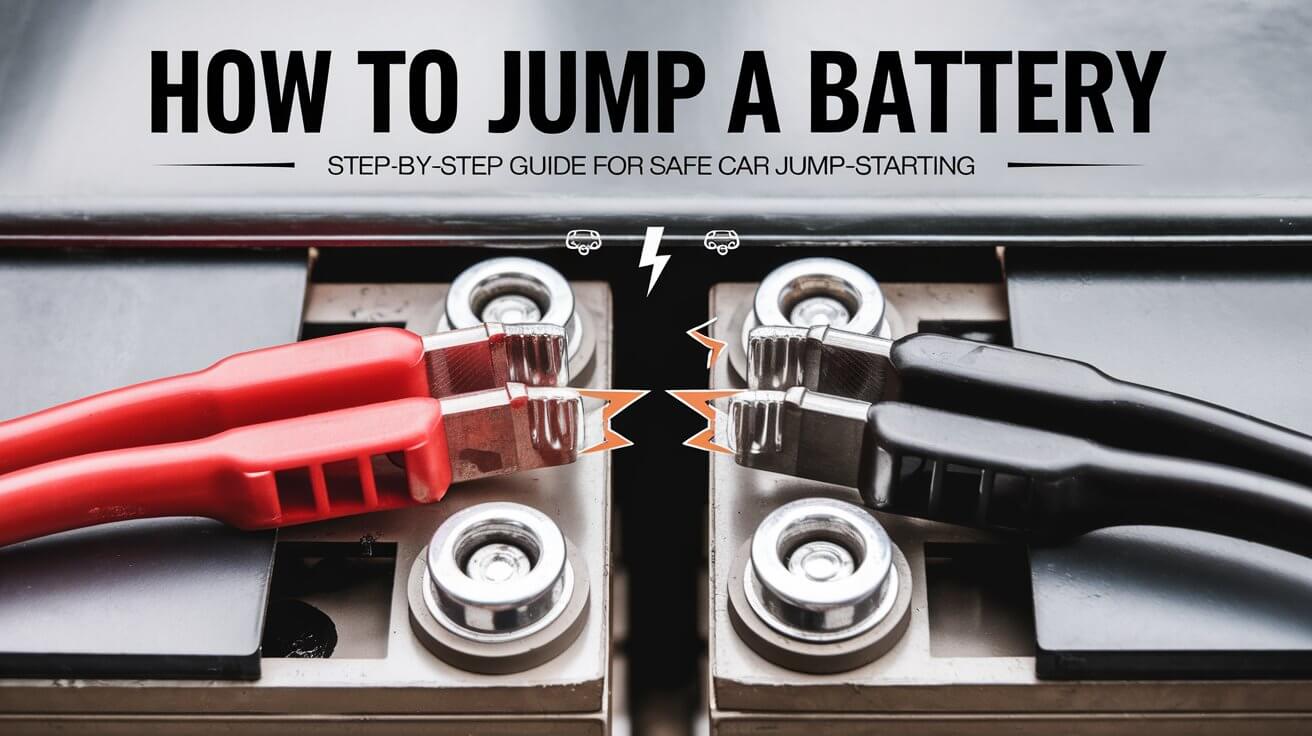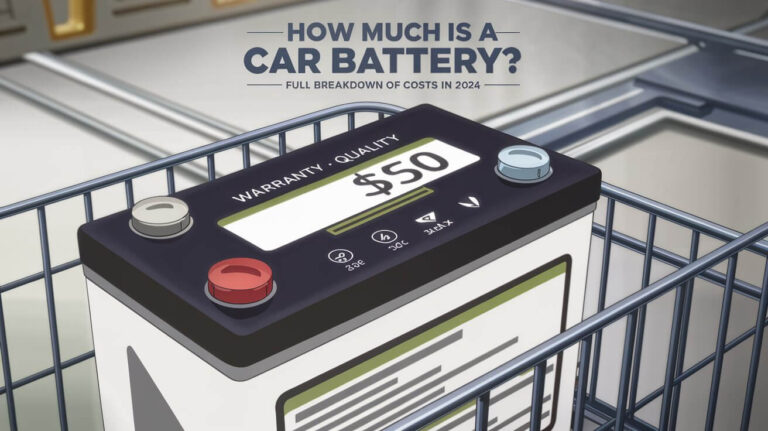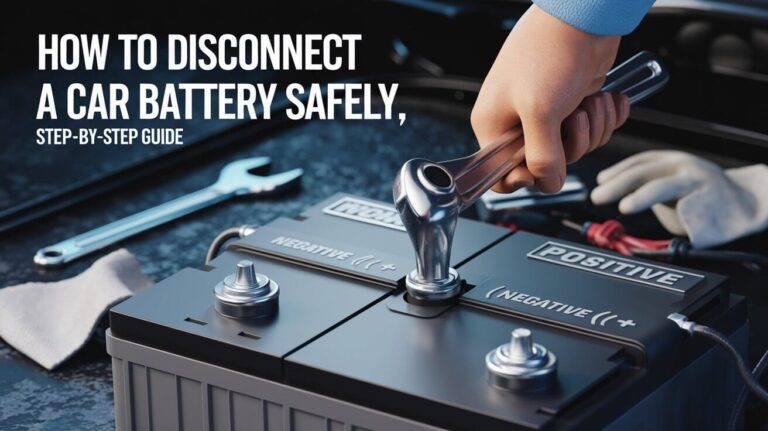How to Jump a Battery: Step-by-Step Guide for Safe Car Jump-Starting

Having a dead car battery is an issue many drivers face, often at the most inconvenient times. Whether you left your lights on or your battery is old, knowing how to jump a car battery can get you back on the road quickly. This guide walks you through the entire process, providing detailed, easy-to-follow instructions and safety precautions to ensure you jump-start your car without any issues.
What You Need to Jump-Start a Battery
Before jumping a car battery, gather these tools:
- Jumper cables: These cables are essential for transferring power from one vehicle to another.
- A second car or portable jump starter: You’ll need a car with a fully charged battery, or you can use a portable jump starter.
- Protective gear: Gloves and eye protection are recommended to prevent injury in case of sparks.
Make sure you also understand your car’s battery setup. Most car batteries are 12-volt, but it’s essential to ensure the voltage matches between the two cars. Jumper cables should be in good condition—damaged or frayed cables can pose safety risks.
Step-by-Step Guide to Jump a Battery
Jump-starting a car involves a few precise steps to avoid damaging your vehicle’s electronics or getting injured. Follow this guide carefully.
Step 1: Position the Vehicles
Park the two cars so that their batteries are close enough for the jumper cables to reach but without touching each other. Both vehicles should be turned off, with the keys removed from the ignition. Ensure that both cars are in park or neutral and that the parking brakes are applied.
Step 2: Connect the Jumper Cables
To avoid any accidents, make sure that the cables do not touch each other once connected. The positive cable is usually red, while the negative cable is black.
- Connect the red (positive) cable clamp to the positive terminal (+) of the dead battery.
- Attach the other red clamp to the positive terminal (+) of the working battery.
- Next, connect the black (negative) cable clamp to the negative terminal (-) of the working battery.
- Finally, connect the remaining black clamp to an unpainted metal surface on the car with the dead battery, away from the battery itself (this acts as a ground to prevent sparks).
Make sure the cables are securely connected and positioned away from moving parts in the engine compartment.
Step 3: Start the Cars
Start the engine of the working vehicle and let it run for a few minutes. This allows the good battery to charge the dead one. After 3–5 minutes, attempt to start the car with the dead battery. If it doesn’t start immediately, wait a few more minutes with the working vehicle running.
Step 4: Remove the Jumper Cables
Once the dead vehicle starts, carefully disconnect the jumper cables in reverse order:
- Remove the black clamp from the grounded metal surface.
- Remove the black clamp from the negative terminal of the working battery.
- Disconnect the red clamp from the positive terminal of the dead battery.
- Finally, remove the red clamp from the positive terminal of the working battery.
Ensure the cables do not touch each other or any part of the vehicle while removing them.
Step 5: Let the Car Run
After a successful jump, let the vehicle with the previously dead battery run for at least 30 minutes. This allows the alternator to charge the battery properly. If the battery doesn’t hold a charge after this, you may need a replacement.
Safety Tips When Jumping a Battery
Jump-starting a car is straightforward, but it comes with risks if not done correctly. Here are some essential safety tips to follow:
- Avoid sparks: Always connect the ground (black) cable to an unpainted metal surface away from the battery to avoid creating sparks near the battery.
- Wear protective gear: Gloves and safety glasses protect you from any potential acid splashes or electrical shocks.
- Check the cables: Never use damaged or frayed jumper cables, as they can cause shocks or fail to jump-start the car.
- No smoking or open flames: Car batteries produce hydrogen gas, which is highly flammable. Avoid smoking or having any open flame nearby when jump-starting your vehicle.
- Remove metal objects: Keep all metal objects (like tools, jewelry, and rings) away from the battery terminals to prevent electrical shorts and potential injury.
Common Issues and Troubleshooting
If your car doesn’t start after following the jump-start procedure, there may be other underlying issues:
- Battery corrosion: Check the battery terminals for corrosion. If there’s a buildup of white, powdery residue, the connection between the battery and cables may be poor.
- Bad battery: If the battery doesn’t hold a charge after the jump, it may need to be replaced.
- Starter or alternator problems: A faulty starter or alternator can mimic the symptoms of a dead battery. If the car still doesn’t start after a jump, these components might be the problem.
- Loose connections: Ensure that the battery terminals are securely connected. Loose or poorly connected cables can prevent the battery from receiving the charge.
What to Do If Jump-Starting a Car Fails
If your car refuses to start even after several jump-start attempts, consider the following possibilities:
- Faulty battery: If your battery is old or has been fully drained multiple times, it may no longer hold a charge and needs to be replaced.
- Alternator issues: If your alternator isn’t charging the battery properly, the car will not start even after a jump.
- Electrical problems: Other electrical components, such as the starter motor or wiring issues, could be preventing your car from starting.
In such cases, it’s best to contact a mechanic for further diagnosis and assistance. Some roadside assistance services can help jump-start or tow your vehicle to a repair shop.
Alternatives to Traditional Jump-Starting
If you don’t have access to another car or prefer not to rely on jumper cables, portable jump starters are an excellent alternative. These devices are compact, easy to use, and eliminate the need for a second vehicle. Portable jump starters also reduce the risk of incorrect connections that could damage your car’s electrical system.
When using a portable jump starter, follow the manufacturer’s instructions closely, as different models may have varying setups. Some jump starters also come with built-in safety features, such as reverse polarity protection and automatic shut-off, which prevent damage if you connect the cables incorrectly.
Frequently Asked Questions About Jumping a Battery
Can Jumping a Battery Damage Your Car?
If done correctly, jump-starting a car should not damage your vehicle. However, incorrect procedures—like connecting the cables to the wrong terminals or removing them while the engine is running—can damage the electrical system or other sensitive components in modern cars. Always follow the instructions carefully and consult your vehicle’s manual for any specific jump-starting guidelines.
How Long Does a Jump-Start Take?
Typically, a jump-start can take anywhere from 5 to 15 minutes. The time required depends on how depleted the dead battery is. If the battery is completely drained, you may need to let the working vehicle run for longer to charge the dead battery enough for it to start.
How Often Should You Replace Car Batteries?
Car batteries generally last between 3 to 5 years, depending on factors like weather conditions, driving habits, and the type of battery. It’s important to check your battery regularly for signs of wear, such as slow engine cranking, dim lights, or corrosion around the terminals.
Conclusion
Jump-starting a car battery is a useful skill that can save you time and money. By following the correct steps and taking the necessary safety precautions, you can quickly get back on the road when faced with a dead battery. Always keep a set of jumper cables in your car and consider investing in a portable jump starter for added convenience. Remember to regularly check your car’s battery health and replace it as needed to avoid future issues.
With this comprehensive guide, you now have all the information you need to confidently jump-start a dead car battery safely and effectively.


